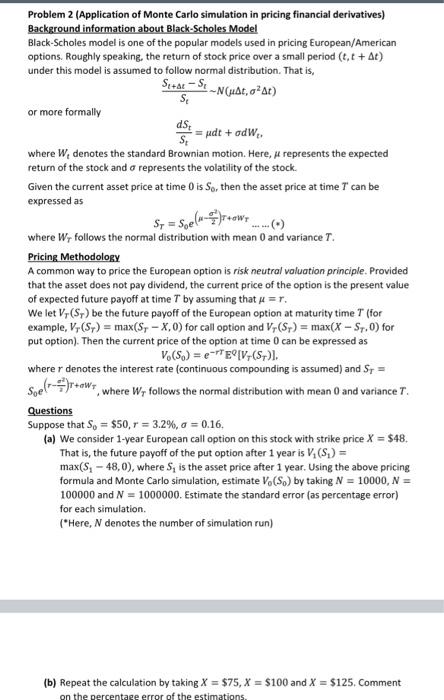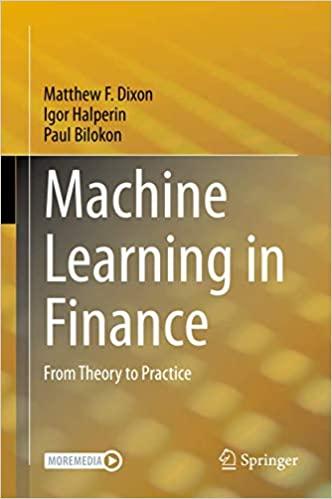Answered step by step
Verified Expert Solution
Question
1 Approved Answer
advanced financial engineering. please help!!! urgent Problem 2 (Application of Monte Carlo simulation in pricing financial derivatives) Background information about Black-Scholes Model Black-Scholes model is
advanced financial engineering. please help!!! urgent 
Problem 2 (Application of Monte Carlo simulation in pricing financial derivatives) Background information about Black-Scholes Model Black-Scholes model is one of the popular models used in pricing European/American options. Roughly speaking the return of stock price over a small period (t.t + At) under this model is assumed to follow normal distribution. That is, Setar - St-Nedt, 0221) S. or more formally ds. S = udt + odw.. where W, denotes the standard Brownian motion. Here, y represents the expected return of the stock and a represents the volatility of the stock. Given the current asset price at time 0 is So, then the asset price at time I can be expressed as $x = sel-)row...( where W, follows the normal distribution with mean 0 and variance T. Pricing Methodology A common way to price the European option is risk neutral valuation principle. Provided that the asset does not pay dividend, the current price of the option is the present value of expected future payoff at time T by assuming that y=r. We let V-(S) be the future payoff of the European option at maturity time T (for example, V. (Sy) = max(s: - X,0) for call option and V,($r) = max(x - Sp.0) for put option). Then the current price of the option at time 0 can be expressed as V. (S) = e-TE [V7(5). where r denotes the interest rate (continuous compounding is assumed) and Sp = where Wy follows the normal distribution with mean 0 and variance T. Questions Suppose that S = $50, r = 3.2%, a = 0.16, (a) We consider 1-year European call option on this stock with strike price X = $48. That is, the future payoff of the put option after 1 year is V. (S) = max(s. - 48,0), where is the asset price after 1 year. Using the above pricing formula and Monte Carlo simulation, estimate V.(S.) by taking N = 10000, N = 100000 and N = 1000000. Estimate the standard error (as percentage error) for each simulation ("Here, denotes the number of simulation run) Soel)row: (b) Repeat the calculation by taking X = $75, X = $100 and X = $125. Comment on the percentage error of the estimations Problem 2 (Application of Monte Carlo simulation in pricing financial derivatives) Background information about Black-Scholes Model Black-Scholes model is one of the popular models used in pricing European/American options. Roughly speaking the return of stock price over a small period (t.t + At) under this model is assumed to follow normal distribution. That is, Setar - St-Nedt, 0221) S. or more formally ds. S = udt + odw.. where W, denotes the standard Brownian motion. Here, y represents the expected return of the stock and a represents the volatility of the stock. Given the current asset price at time 0 is So, then the asset price at time I can be expressed as $x = sel-)row...( where W, follows the normal distribution with mean 0 and variance T. Pricing Methodology A common way to price the European option is risk neutral valuation principle. Provided that the asset does not pay dividend, the current price of the option is the present value of expected future payoff at time T by assuming that y=r. We let V-(S) be the future payoff of the European option at maturity time T (for example, V. (Sy) = max(s: - X,0) for call option and V,($r) = max(x - Sp.0) for put option). Then the current price of the option at time 0 can be expressed as V. (S) = e-TE [V7(5). where r denotes the interest rate (continuous compounding is assumed) and Sp = where Wy follows the normal distribution with mean 0 and variance T. Questions Suppose that S = $50, r = 3.2%, a = 0.16, (a) We consider 1-year European call option on this stock with strike price X = $48. That is, the future payoff of the put option after 1 year is V. (S) = max(s. - 48,0), where is the asset price after 1 year. Using the above pricing formula and Monte Carlo simulation, estimate V.(S.) by taking N = 10000, N = 100000 and N = 1000000. Estimate the standard error (as percentage error) for each simulation ("Here, denotes the number of simulation run) Soel)row: (b) Repeat the calculation by taking X = $75, X = $100 and X = $125. Comment on the percentage error of the estimations 
Step by Step Solution
There are 3 Steps involved in it
Step: 1

Get Instant Access to Expert-Tailored Solutions
See step-by-step solutions with expert insights and AI powered tools for academic success
Step: 2

Step: 3

Ace Your Homework with AI
Get the answers you need in no time with our AI-driven, step-by-step assistance
Get Started


